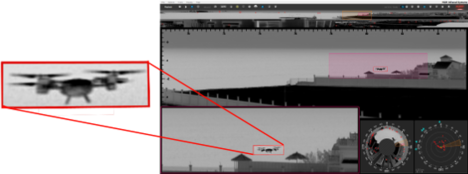Soaring to Risky New Heights: UAVs Buzz around the World’s Critical Infrastructures
02/10/2015 05:59 pm
Article published in the December/January 2015 issue of Homeland Security Today.
The meteoric rise of worldwide unmanned aerial vehicle (UAV) production and popularity is entrenched in a long and difficult history dating back to World War I when the Kettering Bug was commissioned to act as an aerial torpedo by the US Army in 1918. Despite never being deployed before the war ended, even then the value of the technology and ability to replace human operators was recognized. And while UAVs were more widely used as reconnaissance and intelligence tools during the Vietnam War, the use of UAVs in active combat on the battlefield would not come into play until the 1980s when Israel’s Air Force successfully destroyed Syrian aircraft with minimal losses through electronic jamming and real-time video reconnaissance.
With the post-9/11 era and subsequent combat missions in Iraq and Afghanistan, the military UAV demand increased significantly while incalculable improvements were made in communications and GPS navigation technologies . Currently they provide valuable intelligence in Iraq against the Islamic State, but in the past five years there has also been a surge in the recreational and commercial markets, which can be worrying as they have become more accessible, easier to use, inexpensive and can more easily land in the wrong hands for the wrong purpose – in recent months, the terrorist group Hezbollah has flown several UAVs into Israeli airspace.
As reported by Aerospace America’s Global UAV Roundup in 2011, there were 44 nations, 226 manufacturers developing and producing 675 UAVs, compared to 2013 which saw 57 countries and 270 companies with more than 960 unique UAVs in their fleets-a 20% increase in companies, a 30% increase in countries and 40% more aircraft.
As can be expected with the introduction of more unmanned systems to an already crowded airspace with minimal regulations, there’s been too many incidents of personal and commercial UAVs flying dangerously close to some of the world’s most critical infrastructures. Earlier this year, an American Airlines Bombardier CRJ-200 was flying at 2,300 feet and about 5 miles away from its Tallahassee Regional Airport destination when an unmanned, remote-controlled aircraft flew so close to the plane that the pilot was sure he had collided with it. Upon inspection, there’d been no damage or collision. Nevertheless, Jim Williams, the Federal Aviation Administration’s (FAA) chief of the Unmanned Aircraft Systems office, spoke about the potential dangers involved. Williams told Reuters, “Imagine a metal and plastic object—especially with (a) big lithium battery—going into a high speed engine. The results could be catastrophic”.
More recently, a UAV was reported by a JetBlue Airbus A320 pilot two miles from JFK International Airport, one of the busiest airports in the world. A few days later, a Virgin Atlantic pilot about 10 miles from the airport at 2,000 feet reported another unmanned aircraft. That same night, while approaching JFK, a Delta pilot reported seeing a UAV only 10 feet from the wing of a Boeing 737. Current regulations mandate that UAVs must be several miles apart laterally and at least 1,000 feet apart vertically.
These incidents are just a few troubling examples of the more than 150 reported incidents of near-collisions or sightings of UAVs close to small private planes, helicopters and commercial airliners in 2014, according to data released by the FAA. Because many of these incidents occurred over New York City, one of the most congested airspaces in the world, they are a clear-cut reminder that with this rise in UAV technology, there’s a greater obligation in keeping our skies safe and ensuring a secure environment for travelers and airports.
While UAV collisions with airplanes represent serious dangers in the air and on the ground, these perils are intensified when critical infrastructure is involved, such as an electrical substation or nuclear power plant. For example, in France between October 5 and November 2, guards at 13 different nuclear plants witnessed unauthorized, mysterious civilian or commercial drones buzzing dangerously close overhead. This presents a grave and genuine security threat in the age of terrorism. A drone is able to photograph a normally closed off, secured facility to get an inside look at the operations such as guard schedules and security measures. While nuclear sites are designed to withstand the impact of plane crashes and earthquakes, a UAV with explosives could target other sites (and people) on the plant unable to withstand such an attack.
These and many other instances like them have pressured the National Transportation Safety Board and FAA to begin making important groundwork on regulations and classifications on an otherwise unclear topic of concern. On November 17, NTSB concluded that a UAV operated commercially is considered an “aircraft” under 14 C.F.R. § 91.13(a) – thereby its operator may be subject to civil penalties for violating federal aviation regulations.
A solution to detect and track these autonomous aircraft before they are able to cause damage to vital critical infrastructure is paramount to keeping millions of people safe. While traditional radars have trouble picking up UAVs because of their low profile and often low speed, there are security systems in place that are specifically tailored for this kind of technology to prevent the worst from happening. Advanced laser systems could prove to be an effective means in neutralizing a drone before it reaches its target.
Infrared systems and sensors also work well, as they need only a heat signature independent of the time of day in order to pick up a moving object, which any heat producing engine would have. Nevertheless, a high resolution, thermal sensor coupled with advanced algorithms can produce surprisingly good detection. One of the solution for detecting these type of threats is the Spynel, an innovative sensor with powerful and reliable UAV detection and tracking over an ultra-wide area.
Spynel systems feature a 360 degree infrared thermal imaging camera and advanced image analysis software, Cyclope, with automatic detection and tracking capabilities. It can detect and track large thermal engine UAVs in real time up to 11 km away, through any type of inclement weather, day or night as well as smaller quad rotor ones at shorter distances.
With the UAV market expected to double in the next decade, there’s no doubt drone developments are about to kick off a new era for a wide range of applications, such as crop monitoring, cattle herding, live event footage, film and photography, pollutant screening, forest firefighting, and even product delivery. Of course, these exciting developments also come with tangible security concerns. Thus, global regulators are working on new rules; trying to find the tight balance between private and commercial UAV usage that ensures public safety.
The incidents reported in this article show that UAVs can also be turned into unconventional threats, hardly detected by traditional security systems. 360-degree panoramic thermal cameras, with the highest image resolution, such as Spynel systems, bring an innovative solution to these critical security issues, with systematic and automatic detection and tracking of any air target, from anywhere at any time.

